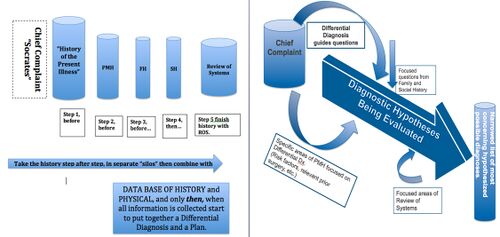Medical History
The process of diagnostic reasoning starts with the medical history. The validity of the history is highly dependent on the mastery of the relevant content, more so than a general diagnostic strategy. Expert clinicians focus more on relevant information, and are highly selective in their use of the retrieved data.
Other than the utility in the process of diagnostic reasoning, the history is used to elicit patient ideas (how they perceive their situation), concerns (what they are worried about), and expectations (what they hope to get out of the consultation).
Traditional vs Chief Complaint Driven Medical History

The traditional method of obtaining a medical history follows a sequential series of 'siloed' categories of information. It starts with the presenting complaint, moves on to the history of presenting complaint (e.g. SOCRATES mnemonic for pain), past medical history, family history, social history, and review of systems. Once all the data is gathered only then is everything integrated.
Expert clinicians tend to rather follow a chief complaint driven history taking. The chief or presenting complaint immediately generates a list of diagnostic possibilities. The clinician then constantly generate and test hypotheses and in doing so are simultaneously problem solving as they elicit the history. The clinician selects a small number of elements from areas of the history as needed to either support or refute different hypotheses, forming the pertinent positives and negatives. In this manner, each question is a test. The selected elements are often dichotomous and exist within the context of the diagnostic schemas and illness scripts in the mind of the clinician. The key differentiating factor between novices and experts is knowledge.
An example of how the traditional approach is not used by expert clinicians is acute knee pain. A key question here in the diagnostic schema is going to be a history of trauma. In the setting of trauma other key questions may include the mechanism and a history of swelling. A skiing injury is going to put the possibility of internal knee derangement high on the list of possibilities and subsequent questions may be directed at that. With a lack of trauma, some key questions may include a history swelling and fever, and a past medical history of osteoarthritis and gout. If a Pacific Islander presents with an obviously hot and swollen knee, the first question is probably going to be whether there is a past history of gout.
See Also
References
- ↑ Nierenberg R, 2020, 'Using the Chief Complaint Driven Medical History: Theoretical Background and Practical Steps for Student Clinicians ', MedEdPublish, 9, [1], 17, https://doi.org/10.15694/mep.2020.000017.1

